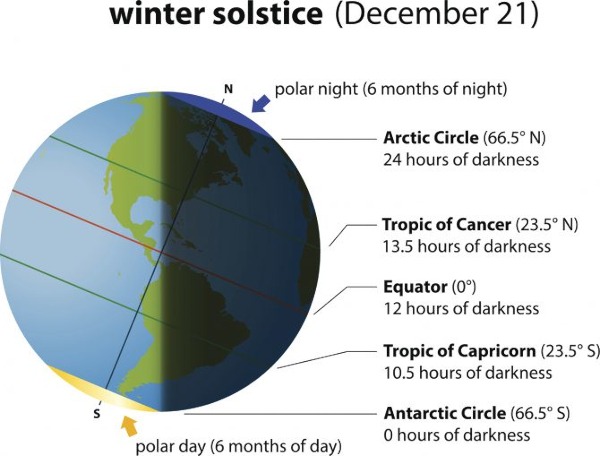Excerpted from EarthSky.org
 The 2023 winter solstice, the arrival of winter, takes place at 7:27 p.m. Pacific time Thursday, December 21, marking the shortest day and longest night of the year in the northern hemisphere, the opposite in the southern, and the beginning of the slow creep of lengthening days leading toward spring. In Bonners Ferry, the sun will rise at 7:35 a.m. and set at 3:51 p.m., giving us eight hours of daylight in which to bask.
The 2023 winter solstice, the arrival of winter, takes place at 7:27 p.m. Pacific time Thursday, December 21, marking the shortest day and longest night of the year in the northern hemisphere, the opposite in the southern, and the beginning of the slow creep of lengthening days leading toward spring. In Bonners Ferry, the sun will rise at 7:35 a.m. and set at 3:51 p.m., giving us eight hours of daylight in which to bask.
On June 21, 2024, the summer solstice six months from now, the sun will rise at 4:43 a.m. and set at 8:52 p.m. … 16 hours and nine minutes of sunshine!
At the winter solstice, Earth is positioned so the sun stays below the North Pole’s horizon. As seen from the latitude 23.5 degrees south of the equator, at the imaginary line encircling the globe known as the Tropic of Capricorn, the sun shines directly overhead at noon. This is as far south as the sun ever gets, and all locations south of the equator have day lengths greater than 12 hours.
The December solstice marks the shortest day of the year in the Northern Hemisphere and longest day in the Southern Hemisphere. But the earliest sunset – or earliest sunrise if you’re south of the equator – happens before the December solstice.
Instead of focusing on the time of sunset or sunrise, the key is in what is called true solar noon, which is the time of day that the sun reaches its highest point in its journey across your sky.
In early December, true solar noon comes nearly 10 minutes earlier by the clock than it does at the solstice around December 21. With true noon coming later on the solstice, so will the sunrise and sunset times.
It’s this discrepancy between clock time and sun time that causes the Northern Hemisphere’s earliest sunset and the Southern Hemisphere’s earliest sunrise to precede the December solstice.
This happens primarily because of the tilt of the Earth’s axis. A secondary but another contributing factor to this discrepancy between clock noon and sun noon comes from the Earth’s elliptical – oblong – orbit around the sun. Earth’s orbit is not a perfect circle, and the closer we are to the sun, the faster we move in our orbit.
Our closest point to the sun – or perihelion – comes in early January. So, we are moving fastest in orbit around now, slightly faster than our average speed of about 19 miles per second (30 km per second). The discrepancy between sun time and clock time is greater around the December solstice than the June solstice because we’re nearer the sun at this time of year.
The precise date of the earliest sunset depends on your latitude. At mid-northern latitudes, it comes in early December each year. At northern temperate latitudes farther north – such as in Canada and Alaska – the year’s earliest sunset comes around mid-December. Close to the Arctic Circle, the earliest sunset and the December solstice occur on or near the same day.
By the way, the latest sunrise doesn’t come on the solstice either. From mid-northern latitudes, the latest sunrise comes in early January.
The exact dates vary, but the sequence is always the same: earliest sunset in early December, shortest day on the solstice around December 22, latest sunrise in early January.
